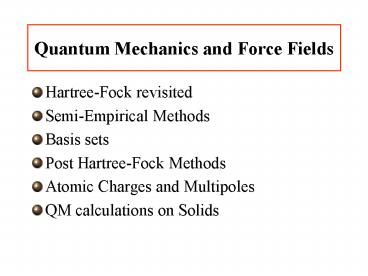Quantum Mechanics and Force Fields - PowerPoint PPT Presentation
1 / 47
Title:
Quantum Mechanics and Force Fields
Description:
Repeat 2 and 3 until ingoing and outgoing coefficients are the same ... Neglect of Diatomic Differential Overlap (NDDO/MNDO,AM1,PM3) Neglected 2-el Integrals ... – PowerPoint PPT presentation
Number of Views:70
Avg rating:3.0/5.0
Title: Quantum Mechanics and Force Fields
1
Quantum Mechanics and Force Fields
- Hartree-Fock revisited
- Semi-Empirical Methods
- Basis sets
- Post Hartree-Fock Methods
- Atomic Charges and Multipoles
- QM calculations on Solids
2
(No Transcript)
3
Without the electron repulsion term
4
(No Transcript)
5
(No Transcript)
6
Self Consistent Field Procedure
- Choose start coefficients for MOs
- Construct Fock Matrix with coefficients
- Solve Hartree-Fock Roothaan equations
- Repeat 2 and 3 until ingoing and outgoing
coefficients are the same
7
SEMI-EMPIRICAL METHODS
- Number 2-el integrals (muls) is n4/8 n
number of basis functions - Treat only valence electrons explicit
- Neglect large number of 2-el integrals
- Replace others by empirical parameters
8
Approximations
- Complete Neglect of Differential Overlap (CNDO)
- Intermediate Neglect of Differential Overlap
(INDO/MINDO) - Neglect of Diatomic Differential Overlap
(NDDO/MNDO,AM1,PM3)
9
Neglected 2-el Integrals
2-el integral CNDO INDO NDDO
-
- -
- - -
-
- -
- - -
- - -
10
Approximations of 1-el integrals
11
(No Transcript)
12
BASIS-SETS
- Slaters (STO)
- Gaussians (GTO)
- Angular part
- Better basis than Gaussians
- 2-el integrals hard
- zz
- 2-el integrals simple
- Wrong behaviour at nucleus
- Decrease to fast with r
13
- STOnG
- Split Valence 3-21G,4-31G, 6-31G
- Each atom optimized STO is fit with n GTOs
- Minimum number of AOs needed
- Contracted GTOs optimized per atom
- Doubling of the number of valence AOs
14
STOnG
15
Contracted GTOs
ci contraction coefficients
16
(No Transcript)
17
Example 6-31G for Li-F
AOs
1s 6 GTOs
2s,2px,2py,2pz 3 GTO per AO
2s,2px,2py,2pz 1 GTO per AO
18
Polarization Functions
Add AO with higher angular momentum (L)
Basis-sets 3-21G, 6-31G, 6-31G, etc.
Element Configuration Polarisation Function
H 1s (L0) p (L1)
Li-F 1s,2s,2px,2py,2pz (L1) d (L2)
19
Correlation Energy
- HF does not treat correlations of motions of
electrons properly - Eexact EHF Ecorrelation
- Post HF Methods
- Configuration Interaction (CI,SDCI)
- Møller-Plesset Perturbation series (MP2-MP4)
- Density Functional Theory (DFT)
20
When AB INITIO interaction energy is not
accessible
Eint Evdw Eelec
Calculate it with a model potential
Neglecting
- Polarization
- Charge Transfer
Approximations to Eelec
- Interacting partial charges
- Interacting multipole expansions
21
The Molecular Electrostatic Potential
22
Properties of the MEP
- Positive part of one molecule will dock with
negative part of another. - Directional effect on complexation.
- Most important aspect of structure activity
correlation of proteins. - Predicts preferred site of electrophilic
/nucleophilic attack. - Minima correlate to strengths of hydrogen-bonds,
Pka etc.
23
Electrostatic Potential Color Coded on an
Isodensity Surface
24
Electrostatic Potential
25
Charges Derived
26
Multipole Derived
27
(No Transcript)
28
Methods for obtaining Point Charges
- Based on Electronegativity Rules (Qeq)
- From QM calculation
- Schemes that partition electron density over
atoms (Mulliken, Hirshfeld, Bader) - Charges are optimized to reproduce QM
electrostatic potential (ESP charges)
29
Atoms in Molecules (Bader)
30
Mulliken Populations
31
(No Transcript)
32
STO3G 3-21G 6-31G
-0.016
0.016
0.219
-0.219
0.318
-0.318
-0.260
-0.788
-0.660
0.065
0.197
0.165
0.279
0.331
0.157
-0.992
-0.470
-0.838
0.183
0.364
0.433
-0.728
-0.866
-0.367
33
Electrostatic Potential derived charges(ESP
charges)
- QM electrostatic potential is sampled at van der
Waals surfaces - Least squares fitting of
34
(No Transcript)
35
QM Calculations on Solids
- K-space sampling
36
(No Transcript)
37
H H H H H H H
38
(No Transcript)
39
H2 H2 H2 H2
40
Overview of Popular QM codes
- Gaussian (Ab Initio)
- Gamess-US/UK ,,
- MOPAC (Semi-Empirical)
41
QM codes for Solids
- DMol3 (Atom-centered BF, DFT)
- SIESTA ,,
- VASP (PlaneWaves, DFT)
- MOPAC2000 (Semi-Empirical)
- CRYSTAL95 CPMD WIEN
42
(No Transcript)
43
(No Transcript)
44
(No Transcript)
45
(No Transcript)
46
(No Transcript)
47
(No Transcript)































